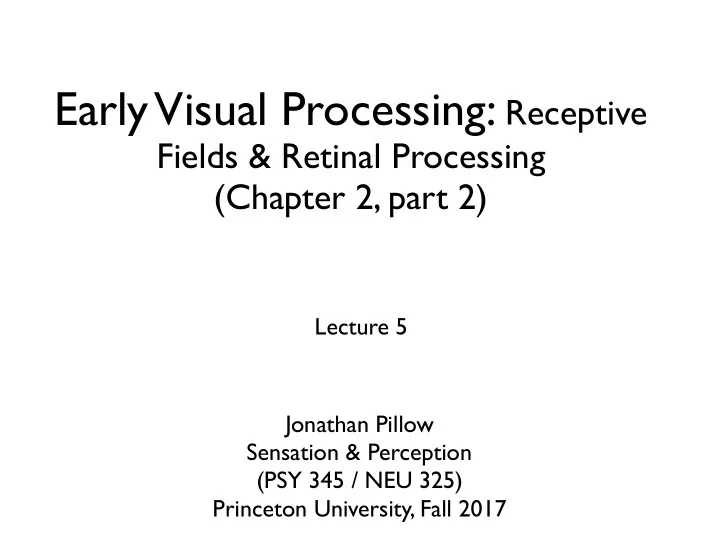

Early Visual Processing: Receptive Fields & Retinal Processing (Chapter 2, part 2) Lecture 5 Jonathan Pillow Sensation & Perception (PSY 345 / NEU 325) Princeton University, Fall 2017
the eye (viewed from above)
• Cornea : The transparent “window” into the eyeball (carries 2/3 of eye’s total refractive power) • Aqueous humor : watery fluid in behind cornea • Lens : allows changing of focus • Pupil : The dark circular opening at the center of the iris in the eye, where light enters the eye • Vitreous humor : transparent fluid that fills main cavity of the eye (gel-like; may contain “floaters”) • Retina : light-sensitive membrane in the back of the eye that contains rods and cones.
• photic sneeze reflex (“sun sneezing”) tendency to sneeze when walking from a dark room into bright light topic of debate: • Aristotle - “sun heats the nose.” • Bacon - closed eyes and didn’t sneeze! • current thinking: “crossed wiring”
Image formation with a lens Goal is to focus the light rays emanating from a single point to a single point on the imaging surface
lenses converging diverging
Refraction: necessary to focus light rays, carried out by lens • Accommodation : process in which the lens changes its shape, altering its refractive power • Emmetropia : no refractive error
Figure 2.3 Optics of the human eye (near-sightedness) (far-sightedness) • too fat / powerful • too thin / not enough • eye is too long accommodation • eye is too short
normal eye - accomodation min max far away object Good near object Good (courtesy ben backus)
normal eye - accomodation min max far away object Good near object Good (courtesy ben backus)
myopic (near-sighted) eye • lens too powerful min max can’t get far far away objects in object focus near object Good
myopic (near-sighted) eye • lens too powerful min max can’t get far far away objects in object focus near object Good
hyperopic (farsighted) eye • lens not powerful enough min max far away object Good near object
hyperopic (farsighted) eye • lens not powerful enough min max far away object Good can’t get near near objects in object focus
• Astigmatism : visual defect caused by the unequal curving of one or more of the refractive surfaces of the eye, usually the cornea • if you have an astigmatism, some lines will have lower contrast
Camera analogy for the eye • Aperture (F-stop) = Iris/pupil . Regulates the amount of light coming into the eye • Focus = Lens . Changes shape to change focus • Film = Retina . Records the image
the retina (“smart” film in your camera)
What does the retina do? 1. Transduction this is a major, • Conversion of energy from one form to another important (i.e., “light” into “electrical energy”) concept 2. Processing • Amplification of very weak signals (1-2 photons can be detected!) • Compression of image into more compact form so that information can be efficiently sent to the brain optic nerve = “bottleneck” analogy: jpeg compression of images
Basic anatomy: photomicrograph of the retina
outer inner retina retinal ganglion cell cone bipolar cell optic disc (blind spot) optic nerve
What’s crazy about this is that the light has to pass through all the other junk in our eye before getting to photoreceptors! Cephalopods (squid, octopus): did it right. • photoreceptors in innermost layer, no blind spot! Debate: 1. accident of evolution? OR 2. better to have photoreceptors near blood supply?
outer inner retina RPE (retinal pigment epithelium) retinal ganglion cell cone bipolar cell optic disc (blind spot) optic nerve
blind spot demo
Recommend
More recommend